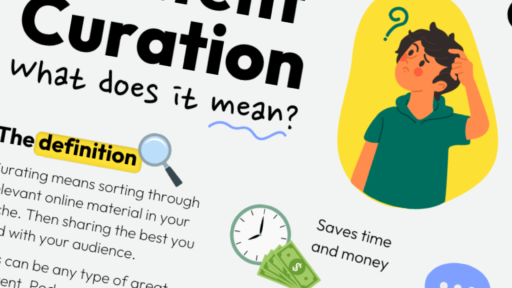The many hours you have spent crafting and honing your CV have paid off. You have landed the interview for your dream content marketing manager job. Congratulations, you absolute legend!
But now, the hardest part: the actual job interview. We understand why you are nervous; 92% of Americans are absolutely terrified of them.
Why are so many candidates petrified about interviews? Well, 41% of interviewees are worried about encountering a difficult question they simply cannot answer.

Don’t fret. We have you covered. We will provide the best answers to some of the toughest content marketing manager interview questions, sure to impress any hiring manager.
14 tough interview questions and how to successfully answer them
Got a pen and paper ready? Good, because you are going to want to take notes. We are about to go through the 14 most-likely questions you will encounter in a marketing manager job interview and how to answer them.
1. What is the main goal of content marketing, and how is this achieved?
What to include:
- Brand awareness: Highlight how making your brand recognizable and memorable is one of the key goals of content marketing. Plus, any personal insights.
- Methods: Detail how you have raised brand awareness amongst your target audience. This can include using different content types, SEO methods, repurposing content, and advertising on multiple platforms.
Example:
“Good content marketing is all about creating brand awareness and attracting your target audience. I am constantly looking at new ways to raise brand awareness by using different types of content for new demographics. I have recently started to use user-generated content to really stand out in our industry.”

2. How could you measure a marketing campaign’s success or failure?
What to include:
- Goals: Explain how important it is to have clear, well-defined goals that the company wants to achieve. For instance, a business may want to increase revenue by 20%. This would mean that focusing on improving conversions would be a big part of your strategy.
- KPIs: State how you have used KPIs as short-term goals to gauge a marketing campaign’s success level.
- Metrics: Mention some of the most common types of metrics and how you have utilized them to measure success. For example, bounce rate, engagement, conversion rate, and shares.
Example:
“When I worked at my last job, I used Google Analytics to monitor the progress of our campaign. I noticed that the conversion rate was incredibly low, which was one of our KPIs.
So, I suggested we change the color of the ‘subscribe’ button, which boosted conversions.”

3. What is one piece of content you are most proud of creating?
What to include:
- Reason: State why you are so proud of this particular piece of work. Explain that you linked it to a particular business outcome. For instance, making an incredible infographic that generated an incredible amount of social shares.
- Content brief: Detail the requirements and limitations outlined in the content brief. If you designed the brief yourself, then describe why these guidelines were put in place.
- Marketing: Explain how you marketed this content to reach the target audience.
- Performance: Discuss how it performed in terms of metrics and achieving KPIs.
Example:
“I created a TikTok video for a client who desired an incredibly engaging and youthful piece of content for their target audience. The client was beyond thrilled with the final product as it nailed the brief and generated a lot of engagement through social media marketing.”

4. How do you decide what type of content to create?
What to include:
- Target audience: Explain how you have used target audience research to gauge what type of content to create.
- Keywords: Mention how keywords have guided you in finding a topic for a piece of content.
- Client needs: If applicable, detail how a client’s needs and wants have influenced your choice of content.
- Topic research: Discuss how in-depth research of social media and relevant sources have allowed you to pinpoint what specific subjects are popular in the chosen topic.
Example:
“I had to create about the subject of TikTok crazes. We realized that the target audience was on Facebook, so our team created a short piece of video content. Through my research of the topic, we found that the Wednesday Addams dance was currently popular, which was supported by both keywords ‘Wednesday’ and ‘Addams’ ranking highly.”

5. What is your opinion of our content?
What to include:
- Example: Showcase that you have done your homework by referencing a real example of their content.
- Pros: Highlight what you really enjoyed about the example.
- Cons: Mention a singular, non-insulting criticism of the example. Do not go off on a rant listing all the company’s failings.
- Recommendation: Advise how the company could optimize their content. For instance, if you noticed a lot of broken backlinks then we could advise that they should reach out to the linking website to fix them.
Example:
“I have absolutely loved scouring your blog for content. One in particular about influencer marketing really caught my eye. I love how it was so engaging and humorous. However, I would have loved to have seen a bit more eye-catching imagery and real-world examples.”

6. What is an example of a successful content marketing strategy you admire?
What to include:
- Example: Before the interview, find a selection of incredible examples that really wow you.
- Reason: Explain why you believe this to be a successful campaign.
- Evidence: Provide clear evidence and examples to support your reasoning.
Example:
“Wow, there are so many incredible content marketing campaigns to choose from. I admire SHEINS’s use of social media platforms. Their use of user-generated haul videos on TikTok and Instagram is a stroke of marketing genius. The advertising creates itself at no extra cost to the company.”

7. How would you successfully promote your content?
What to include:
- SEO: State how you have used organic SEO techniques to promote a piece of content, including link building, keyword targeting, and relevant metadata.
- Platforms: Give an example of when you have distributed content to multiple platforms either manually or using promotion tools such as the fabulous Quuu.
- Repurposing: Describe a time when you have had to repurpose content to achieve your goals.
Example:
“We had a blog that we really wanted to push out there. The team started by researching what keywords would make it stand out. I then had the brilliant idea of reaching out to influencers in an attempt to build backlinks. But it was not working, so the team repurposed the content as a YouTube video which saw a surge in engagement.”

8. What skills do you have that make you a successful marketing specialist?
What to include:
- Job description: Read the job description carefully and highlight any soft or hard skills mentioned.
- Hard skills: Mention any of your relevant occupational-specific skills to a marketing role.
- Soft skills: Do not only rely on your business prowess; it is important to emphasize your interpersonal skills too.
| Hard skills | Soft skills |
| SEO | Team management |
| Content creation | Problem-solving |
| Editing | Communication |
| Research | Creative |
| Data analysis | Adaptable |
| Content promotion | Attention to detail |
| Copywriting | Leadership |
Example:
“I have fantastic communication skills that allow me to lead a marketing team effectively and motivate them to excel. I also bring a wealth of SEO knowledge about backlinking and keywords that I believe will be a real asset to your company.”
9. How does SEO drive a content marketing campaign?
What to include:
- Importance: Demonstrate that you understand the importance of SEO in relation to content marketing.
- Methods: Provide a few examples of effective methods that will boost a website’s ranking.
- Black hat: Show that you understand that black hat SEO techniques, such as keyword stuffing and hidden text, are frowned upon in the industry.
Example:
“As a content writer, it is important to always focus on search engine optimization to move our content further up the search result pages. This means we must create SEO-rich content filled with keywords and effectively labeled with metadata.”

10. What is a weakness in your content marketing knowledge?
What to include:
- Ever-changing: Mention how the world of digital marketing is constantly evolving, so there is always something new to learn.
- Flaw: Highlight one skill you wish to work on, such as better SEO knowledge. Do not make it a massive, glaring flaw that could lose you the job.
- Improvement: Show how you are working towards improving this skill.
- Compliment in disguise: Do NOT provide a positive dressed as a weakness; hiring managers can spot these a mile away. For instance, do not mention how you are too attentive to detail or care too much about your work.
Example:
“Well, I am constantly trying to improve my knowledge of digital marketing as it is an industry that is continuously evolving. However, I would also like to improve my public speaking ability, so I have recently joined a debate club to help hone this skill.”

11. How would you approach writing about a topic you have limited knowledge on?
What to include:
- Not fazed: Show confidence that you can handle any subject matter.
- Research: Describe a time when you had to research a topic that you knew nothing about.
- Thought leaders: Highlight how thought leaders have guided your writing and provide specific examples.
- Planning: Let the interviewer know how you have structured this research into an organized plan.
Example:
“I once had to write about car engines. I have no idea about them. But I remained calm and researched the topic looking towards industry leaders like Ralph Gilles for guidance. Once I finished my research, I organized it into a clear, well-structured plan before I wrote the article.”

12. How have you created a brand voice for your clients or employers?
What to include:
- Values and principles: State how your brand’s values and principles influenced your voice.
- Previous content: Explain how looking at previously published content is a fantastic means of understanding a brand’s voice.
- Research: Show how you did extensive research on your brand’s niche to find the most effective tone.
- Target audience: Provide an example of how the target audience has guided your brand voice.
- Style guide: Mention if you have created a style guide to help future content writers maintain the style and tone of your content.
Example:
“Researching our target audience showed that our consumers engaged the most with humorous content. Our motto became ‘make fishing fun’, and that influenced our brand voice. So, we created a style guide to help new content writers maintain our brand voice throughout all our marketing channels.”

13. How do you keep up with the constant developments and changes in our industry?
What to include:
- How: Showcase how you remain relevant in the fast-changing world of content marketing by subscribing to blogs, following industry thought leaders, and watching marketing YouTube channels.
- Example: Provide a recent example of a new technique or method that you think is important to the industry.
Example:
“Yeah, the industry is constantly changing, and it is important to keep up so we don’t miss out on new trends and techniques. I am constantly reading blogs like The Content Strategist and MarketingProfs. The other day I read a fascinating article about how to rank higher in voice search results.”

14. How would you transform a failing content marketing campaign into a success?
- Example: Ideally, reference an example of when you turned around a failing content marketing campaign or create a scenario. For instance, if you improved a campaign by optimizing the metadata to rank higher in SEO.
- Metrics: Detail how metrics showed you how the campaign was not succeeding. For example, if the bounce rate is high, then that is an indication that your content is failing to engross your readership.
- Implement: State how it was important to generate a comprehensive list of ideas to resolve this issue and implement them.
- Results: Highlight how these changes improved performance.
Example:
“One of our content marketing campaigns was struggling and looking at the metrics, it was due to an obvious issue with conversions. We sat down as a team and figured out we needed to perform A/B testing to find a solution. The results showed us we needed to change our call to action.”
Conclusion
And there you go. 14 interview questions and 14 top-tier answers.
One last top tip? Do not rehearse the answers we have provided.
Instead, treat them like a customizable template. Before your interview, write down your answers to these questions. Add your personality and insights to really wow the hiring manager.
From all of us here at Quuu, we wish you the best of luck in your next job interview. Go get ‘em, tiger!

What are some difficult interview questions you have been asked? What are your top tips for nailing an interview? Settle down and write your own answers to our 14 questions to ensure you are the best candidate possible for your dream job.





